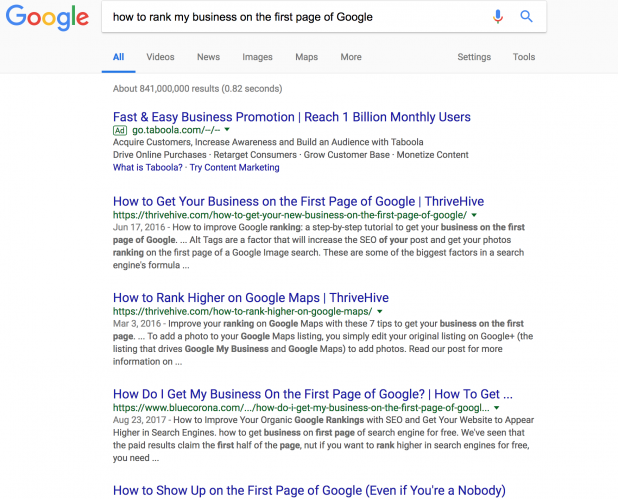Want to make it easier for potential customers to find you? Then you need to get friendly with Google or whatever search engine your ideal customers turn to for answers.
Optimizing your business for search engines boosts your search ranking and, with time, patience, and hard work can get you that coveted front page spot which leads to more conversions. Let’s take a look at some SEO tips you can use right away to get your online business ranking where it belongs.
What Search Engines Want
All search engines want the same thing– to deliver the most relevant search results possible. They’ve got a vested interest in showing the searcher a site they’ll love because it creates trust. If the user trusts the search engine, they’ll come back and use it over and over again bringing in ad revenue and helping improve the engine’s algorithm through repeated use. It’s a classic win-win scenario.
So if you want to rank your business, you need to help the search engine achieve its objective by creating a site that’s worth visiting. The time for black hat SEO techniques is long gone– if you want to rank, you need to think long term.
While a lot of the tips are designed with the Google algorithm in mind, they will work for Yahoo and Bing as well because all search engines share a common objective. Now let’s get down to the practical elements.
Optimize Your Site
If you want Google to send visitors your way, you need to create a great user experience. Here are some key elements you can’t afford to ignore.
1. Check your page loading speed
Google’s been paying attention to your page speed since 2010– faster sites get the preferential treatment. Few things are more frustrating to users than clicking on a page, only to have to wait ages for it to load so why on earth would Google send them there? They won’t. That’s why checking your load speed is the first step of optimizing your site.
Use a tool like the Google PageSpeed Insights to get an accurate read on your site’s speed. Or, if you want to test load speed from various locations, try out the Pingdom speed testing tool.
Load speed is affected by the proximity of the server to the searcher’s location so location testing is really important if you want to attract a global audience.
Here are some ways you can improve your page loading speed.
- Switch hosting providers: Choose a provider with a server distribution that fits with your audience.
- Use a Content Distribution Network: A CDN will boost content delivery speeds and vastly improve loading times.
- Optimize videos and images: Avoid hosting videos directly on your site as they eat a lot of bandwidth– use a hosting service like YouTube, Vimeo, or Wistia instead. Experiment with image resolution until you find the sweet spot between high quality res and fast loading times.
2. Be mobile friendly
We surf the web on our phones and tablets as well as desktops so your site needs to be responsive or it won’t rank well. Google rolled out the mobile update in 2015— the update boosted the ranks of mobile-friendly sites. If your site isn’t smartphone ready yet, it’s time to board that ship or your rankings will continue to suffer.
Use Google’s own testing tool to check if your page is mobile friendly and make the necessary changes as soon as possible.
3. Clean your house
Broken links? A super-confusing page structure? Those things need to go if you want to rank.
Use a tool like the Google Webmaster tool or the Screaming Frog SEO Spider to check your site for broken links and clean it up. However, even if even if you watch your site like your pup watches your dinner plate, stuff will go wrong. A good 404 page can help you turn this around and keep users on your site even if they have a real life encounter with a broken link.
Customize your 404 page and use it to alleviate annoyance and take the user somewhere else.
4. Create (and implement) a solid keyword strategy
Keywords tell search engines (and people) what a piece of content is all about. They are usually the word(s) a user types into a search engine so they can find what they want.
The search engine scours all the sites for the search term and tries to deliver the most accurate results possible. As search engines are getting better at natural language processing, they also look for parts of the term and try to place it in a larger context.
To rank, you need to research what your ideal customers are looking for. Keyword research is the first part of writing effective copy and building a successful content marketing strategy. Use keyword research tools like the Google AdWords KeyWord Planner or UberSuggest to understand what people are after.
The type of keyword a user types into the search engine can help you understand their intent. We can actually split keywords into two categories based on that intent– informational and transactional.
Let’s say you run a business that helps people start an online business. Informational search strings like “how to start an online business” indicate that the searcher is looking to learn, not buy. However, a transactional search string like “best course on starting my online business” indicates intent– this user is looking to spend some cash. By using both types of keywords in your strategy, you can optimize content for specific stages of the buyer’s journey and improve your rankings.
5. Create killer content
Once you’ve done the keyword research, you need to create content around it. When it comes to great content, less is more. Your content needs to reflect what your business is about and what your audience wants to know. Answer questions and address problems based on your keyword research.
The quality of your content doesn’t just come down to the words– the way you present it counts too. No one is going to stick around to read a wall of text– even if it’s the best thing since the first Supernatural script dropped. Format your content by using headings and subheadings to create blank space and improve readability.
Don’t forget to optimize the images and video on your site. While image search has come a long way in recent years, search engines still rely on metadata for context. Use a relevant filename, balance out the size and quality, and add alt text that helps the engine understand what’s going on.
6. Create a linking strategy
Outbound links to authority sites and inbound links from authority sites in your industry and niche give your website both context and legitimacy. It’s like social proof for search engines– it tells the algorithm that other key sources in your industry trust you.
Use a guest posting strategy to build your authority. Research important publications and blogs in your field and check if they accept guest posts. Next, come up with a pitch that’s focused on how your post can help them, help them help their audience, and build your authority like a pro.
SEO is a long game
Search algorithms are constantly evolving. The Google algorithm changes happen on a daily basis and no one knows exactly how the rankings work. What we do know is that Google, and the other search engines, have a vested interest in showing the best, most relevant results possible. Any changes are going to support this end goal. One surefire way to stay ahead of the competition and rank high is by helping Google do just that.






